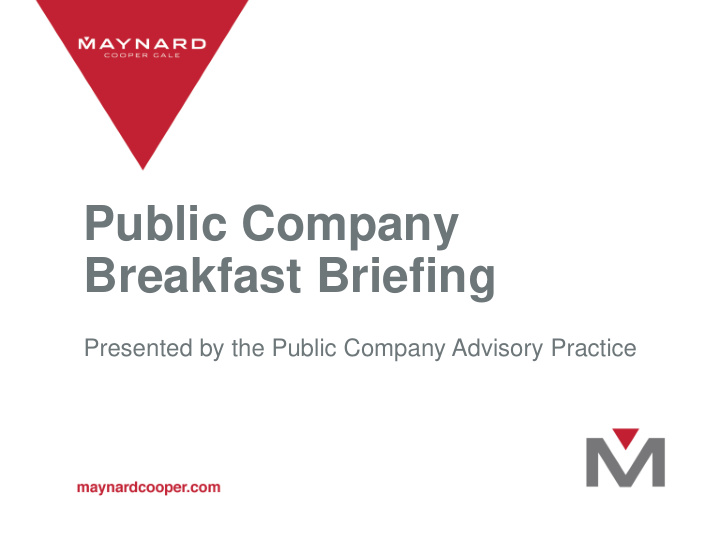



Public Company Breakfast Briefing Presented by the Public Company Advisory Practice
Disclosure Hot Topics: Critical Audit Matters
Dealing with Critical Audit Matters
Auditor’s Reporting Model - Critical Audit Matters On June 1, 2017, the Board adopted a new auditor reporting standard, which the SEC approved on October 24, 2017. Includes requirement to disclose Critical Audit Matters (CAMs) Effective date - CAMs requirements take effect for audits for fiscal years ending on or after June 30, 2019, for large accelerated filers; and for fiscal years ending on or after December 15, 2020, for other filers.
Auditor’s Reporting Model – Critical Audit Matters Definition: A CAM is a matter arising from the audit of the financial statements that was communicated or required to be communicated to the audit committee and that: (1) relates to accounts or disclosures that are material to the financial statements, and (2) involves especially challenging, subjective, or complex auditor judgment. Communication requirements - The communication of each CAM in the auditor's report includes: Identification of the CAM; Description of the principal considerations that led the auditor to determine that the matter was a CAM; Description of how the CAM was addressed in the audit; and, Reference to the relevant financial statement accounts or disclosures.
Factors the Auditor Should Take Into Account in Determining CAMs The auditor's assessment of the risks of material misstatement, including significant risks; The degree of auditor subjectivity in determining or applying audit procedures to address the matter or in evaluating the results of those procedures; The nature and extent of audit effort required to address the matter, including the extent of specialized skill or knowledge needed or the nature of consultations outside the engagement team regarding the matter; The degree of auditor judgment related to areas in the financial statements that involved the application of significant judgment or estimation by management, including estimates with significant measurement uncertainty; The nature and timing of significant unusual transactions and the extent of audit effort and judgment related to these transactions; and The nature of audit evidence obtained regarding the matter.
Emerging Trends from the Initial Dry Runs Most common CAMs from PwC’s dry run program relate to auditing of: Goodwill and intangible impairment assessments Valuations of intangible assets relating to a business combination Income tax accounting Revenue Valuations of financial instruments Source: PwC, Q1 financial reporting consideration, March 27, 2019
Some Insights from the Recent PCAOB Guidance When communicating CAMs, the auditor should identify which of the three criteria apply to each CAM The auditor should describe why the matter involved especially challenging, subjective or complex judgment The auditor is not expected to provide information that is not publicly available, but “publicly available” can mean any number of sources, and not merely the financial reports A control deficiency is not itself a CAM, but it should be considered in determining whether the auditing of the affected financial statement elements constitutes one or more CAMs Not all critical accounting estimates or significant risks necessarily will be CAMS but they should be considered
Recommend
More recommend